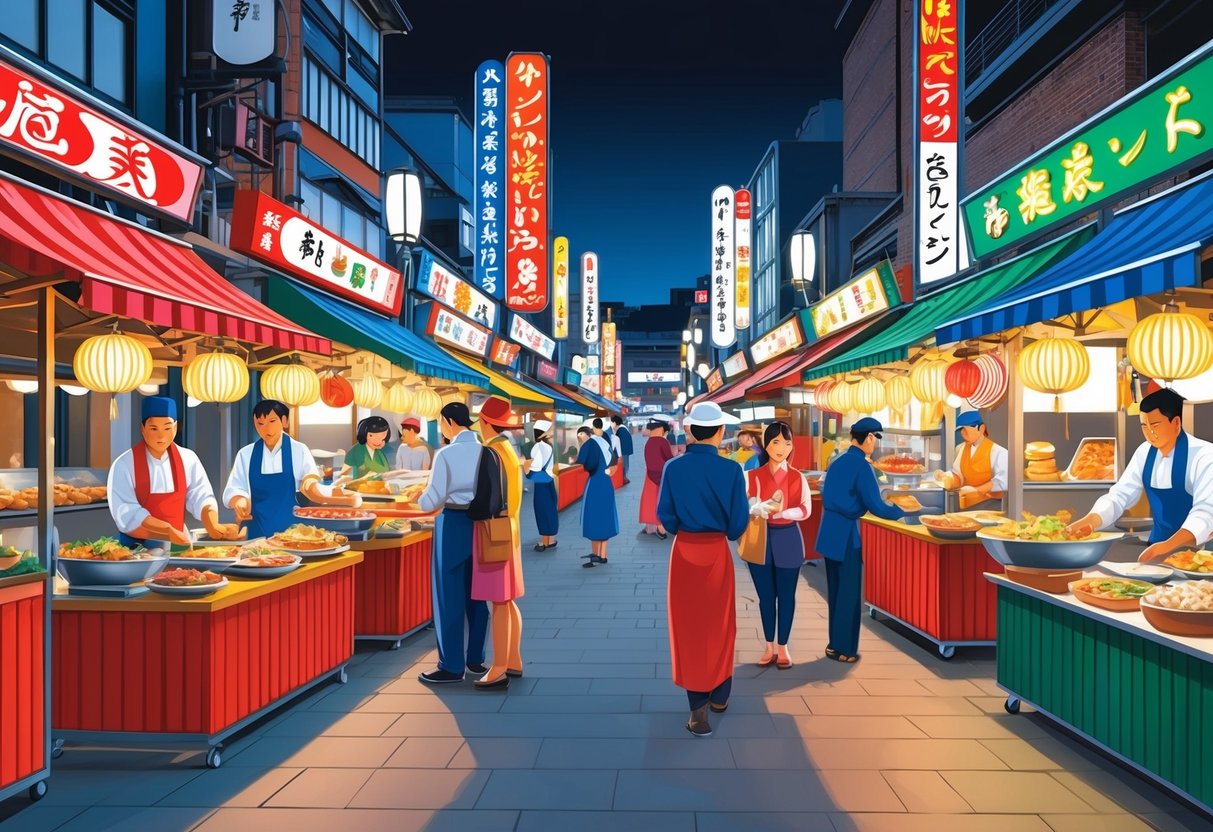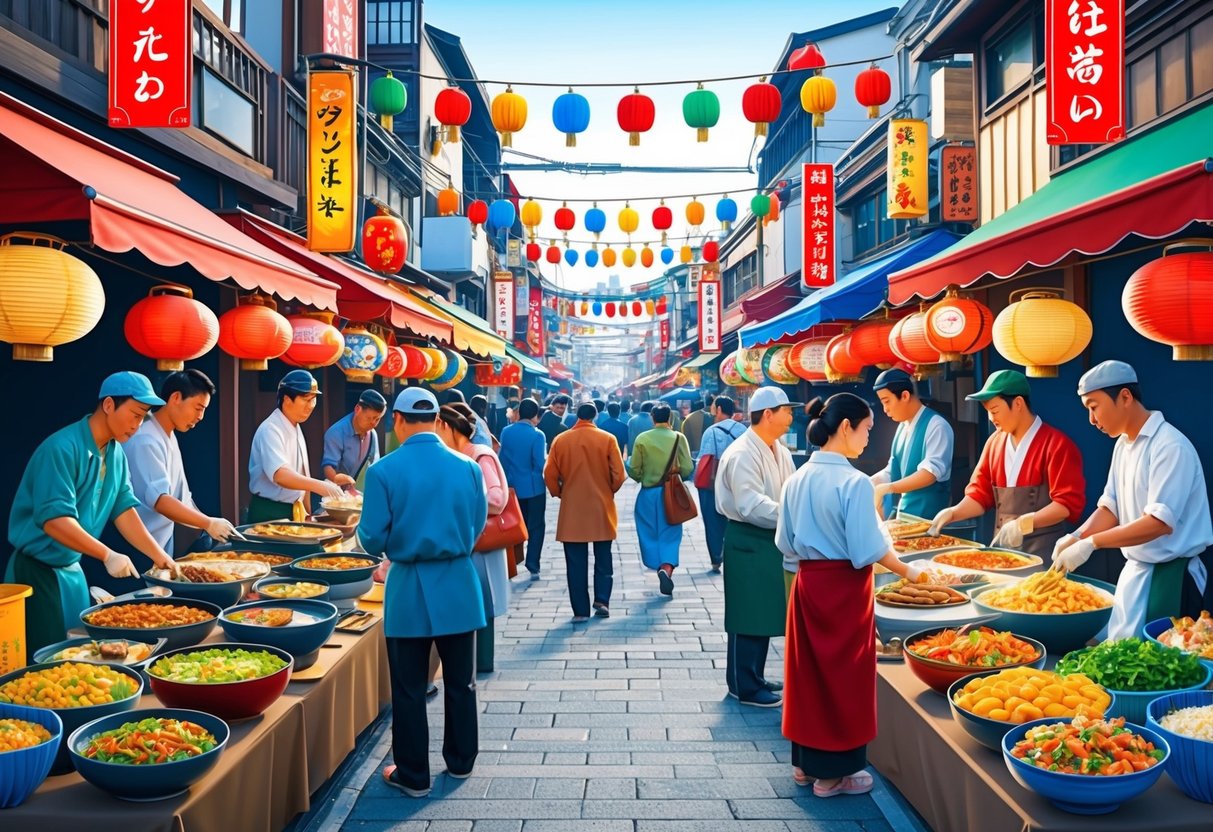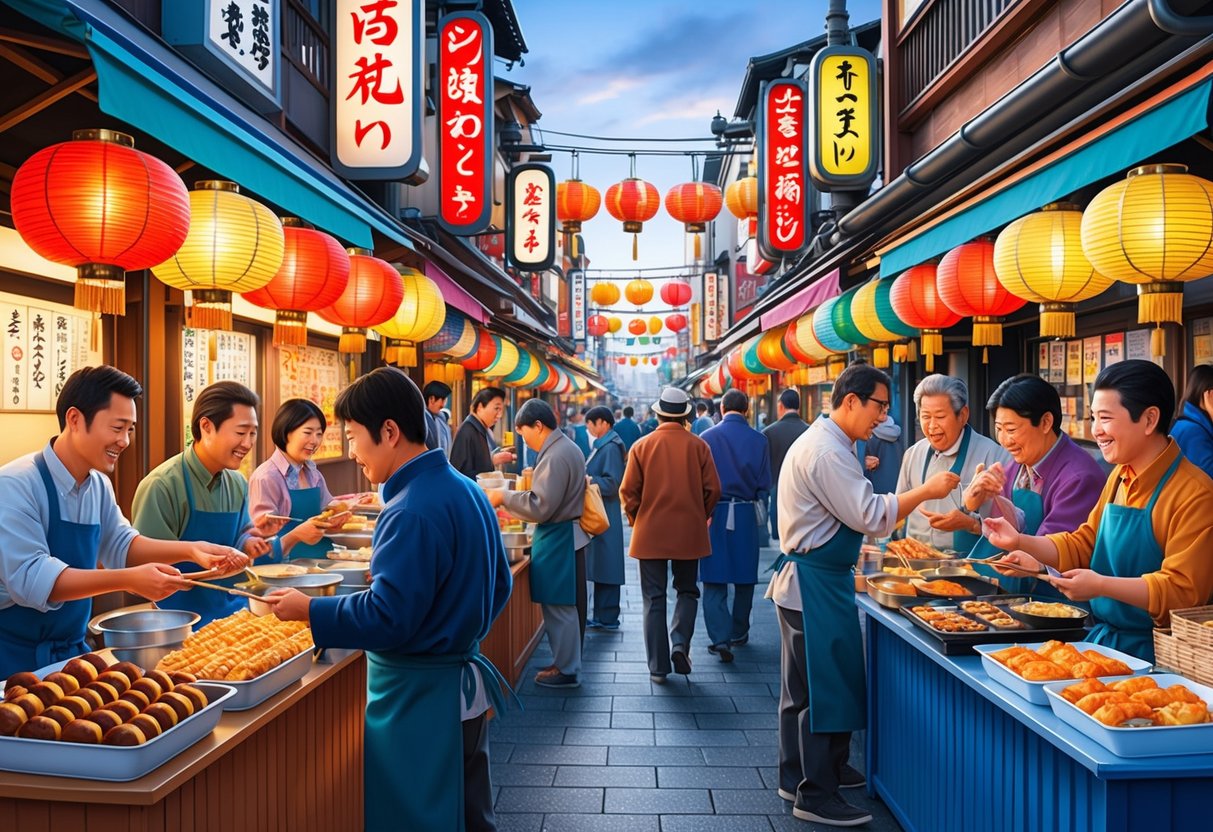
Japan’s vibrant street food culture offers a unique way to experience the country’s rich culinary history and innovation. Stalls and yatai lining busy streets and market alleys entice visitors with the savory aroma of freshly grilled yakitori, the distinct flavors of takoyaki, and the comforting warmth of oden.
Sampling Japanese street food means diving into a world of signature dishes and bold flavors that are both traditional and imaginative.
Every region in Japan brings its twist to classic street foods, from the sweet, fluffy ningyo-yaki found in Tokyo to sizzling menchi katsu cutlets served piping hot. Adventurous eaters and casual snackers alike are drawn in by dishes such as okonomiyaki, fresh soba noodles, and mitarashi dango, all of which reflect the diversity of Japanese cuisine and culinary creativity.
Whether you’re planning a food-filled adventure across Tokyo’s stalls or seeking inspiration to recreate favorite flavors at home, exploring Japanese street food promises new tastes and memorable experiences.
For anyone passionate about food, this journey through Japan’s markets and festivals offers endless opportunities to discover new recipes and savor some of the country’s most beloved snacks and treats.
Origins and History of Japanese Street Food

Japanese street food traces its roots to the bustling activity of traditional yatai stalls and centuries-old culinary customs, with a rich blend of regional influences and evolving traditions. Changes in Japanese society and food culture continue to shape the variety and accessibility of popular street snacks and delicacies.
From Yatai Stalls to Modern Markets
Yatai—portable food stalls—emerged in Japan during the Edo period (1603–1868), offering quick, affordable meals to common people, travelers, and merchants. These stalls became fixtures at festivals and along busy streets, fueling Japan’s early street food culture.
Typical fare included oden, tempura, and soba noodles. Yatai are small wooden carts or temporary setups, often clustered in lively areas.
Vibrant nighttime gatherings centered around these stalls have long contributed to the fabric of Japanese social life and urban commerce. Regional markets and open-air events soon adopted these mobile street vendors, broadening their influence.
By the 20th century, permanent street food markets began to emerge in cities, creating hubs for classic and modern snacks. Today, many famous Japanese street foods—such as takoyaki, yakitori, and okonomiyaki—continue to be enjoyed both at traditional yatai and contemporary food markets.
For a deeper look at staple dishes offered by stalls and food vendors, visit this guide on Tokyo street food.
Influences from Regional Japanese Cuisine
Japan’s diverse geography and rich cultural heritage give rise to localized street food specialties. In Osaka, takoyaki (octopus balls) and okonomiyaki (savory pancakes) reflect Kansai flavors, while in Hiroshima, a twist on okonomiyaki includes layered noodles.
Hokkaido is famous for piping hot miso ramen, while Fukuoka’s yatai sell distinct tonkotsu ramen. Street food in each region adapts to local ingredients, climate, and historic food customs.
For example, coastal regions incorporate abundant seafood into grilled skewers and snacks, while rural areas highlight mountain vegetables and rice-based fare. These regional differences foster a dynamic and varied Japanese street food landscape.
The blending of seasonal produce, local spices, and unique preparation methods result in distinctive tastes, textures, and experiences. Exploring different regions helps visitors and locals alike discover the true breadth of Japanese street food, from sweet mitarashi dango to savory yakisoba and beyond.
Evolution of Street Food Traditions
Japanese street food has evolved in response to social change and urbanization, especially since the 20th century. Major festivals, urban development, and global exposure have modernized the ways street food is prepared and served.
While historical yatai catered to working-class city dwellers, modern street food often targets tourists and food enthusiasts. Street food vendors have adapted recipes and techniques to meet changing tastes, food safety standards, and the popularity of international flavors.
Innovations such as mobile food trucks and themed markets merge traditional food culture with contemporary trends, making street cuisine accessible year-round. Despite modernization, the communal tradition of eating around yatai stalls remains rooted in Japanese culture.
These gatherings are more than convenience—they preserve shared culinary memories and transmit the intangible cultural heritage that defines Japan’s enduring street food scene. For more information on iconic dishes with deep cultural roots, refer to this article listing must-try Japanese foods.
Essential Japanese Street Food Dishes

Japanese street food stands out for its versatility, bold flavors, and distinctive textures. Many of these popular dishes combine savory and umami tastes and are quick to prepare, making them staples at festivals, food stalls, and night markets.
Takoyaki: Octopus Balls
Takoyaki are bite-size, round balls made from a savory wheat-flour batter filled with diced octopus, green onion, pickled ginger, and tempura scraps. A signature street food from Osaka, these octopus balls cook in special molded pans, resulting in a crisp exterior and creamy center.
Each ball is gently flipped with skewers as it cooks to ensure its smooth, spherical shape. Once ready, takoyaki is drizzled with tangy takoyaki sauce, rich Japanese mayonnaise, and bonito flakes that wave from the steam.
Sometimes, they are sprinkled with seaweed powder for an extra savory note. Takoyaki is best enjoyed piping hot and is a festival favorite for locals and visitors alike.
The combination of the chewy octopus and the soft, almost molten batter gives this snack its unique texture and flavor. To make classic takoyaki at home, a takoyaki pan is highly recommended for authentic results, or you can try simplified versions available in many Japanese street food recipes.
Okonomiyaki: Savory Pancakes
Okonomiyaki is often described as a Japanese savory pancake but features a much heartier base of shredded cabbage, eggs, flour, and a variety of mix-ins. Regional variations are common, especially between Osaka and Hiroshima—the Osaka style mixes ingredients together, while the Hiroshima version layers them and adds yakisoba noodles.
Traditional toppings include a sweet-savory okonomiyaki sauce, mayonnaise, dried seaweed, and bonito flakes, creating an appetizing contrast of textures. Okonomiyaki translates to “grilled as you like it,” highlighting its customizability.
Diners can add pork belly, seafood, cheese, or mochi to suit their taste preferences. Many food stalls will grill each pancake to order, slicing it into easy-to-eat pieces.
This dish is a filling meal and showcases a balanced blend of umami-rich ingredients, crisp cabbage, and a tender interior. For more on authentic regional versions, visit Osaka style okonomiyaki.
Kushikatsu: Skewered and Deep-Fried Foods
Kushikatsu, also called kushiage, consists of skewered meat, seafood, or vegetables coated in panko breadcrumbs and deep-fried until golden. Originating in Osaka, kushikatsu is a staple of izakaya pubs and casual standing bars.
These skewers use thin bamboo sticks, making them easy to eat on the go. Common kushikatsu options include pork, shrimp, lotus root, and mushrooms.
The skewers are served with a communal container of savory dipping sauce, but double-dipping is considered poor etiquette. Restaurants may offer assorted platters or allow diners to choose individual skewers to suit their tastes.
Kushikatsu’s key appeal lies in its contrast between the crispy outer shell and juicy, flavorful interior. This dish pairs well with cabbage leaves, which cleanse the palate between bites.
More information and recipe variations can be found in many Japanese street food collections.
Yakisoba: Stir-Fried Noodles
Yakisoba is a classic street food featuring wheat noodles stir-fried with thinly sliced pork, cabbage, carrots, and onions in a tangy, savory sauce. Despite the name “soba,” the noodles used are not buckwheat but are made from wheat flour, making them springy and able to absorb sauces well.
Vendors typically cook yakisoba on a large flat grill, tossing the noodles and vegetables with a Worcestershire-style sauce that provides a signature sweet and savory flavor. Toppings such as pickled ginger, seaweed flakes, and bonito shavings add extra depth.
Yakisoba is often served at summer festivals, sports events, and open-air markets. It is portable and satisfying, offering balanced flavors and plenty of texture in each bite.
Recipes for authentic preparations and creative variations appear in most Japanese street food recipe guides.



